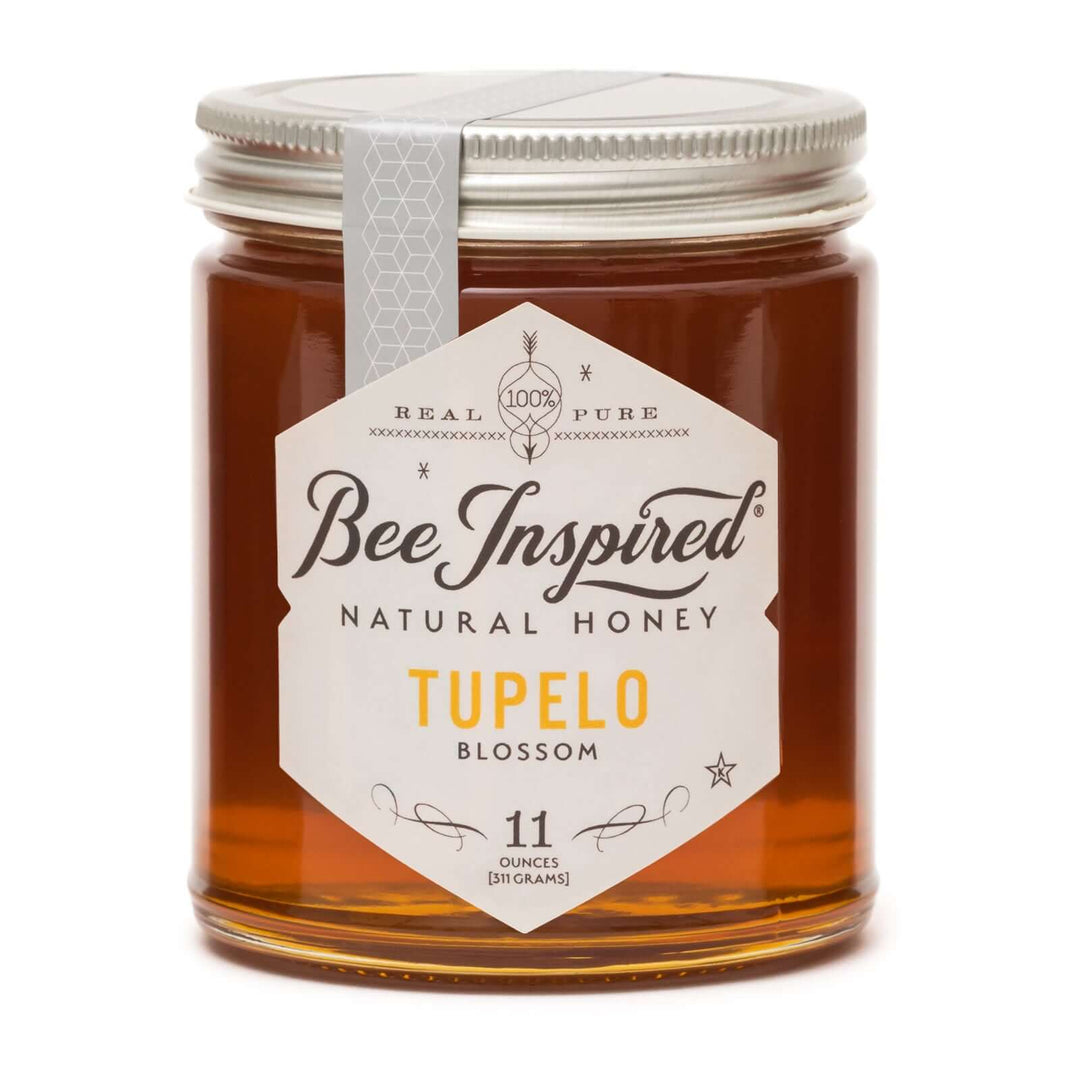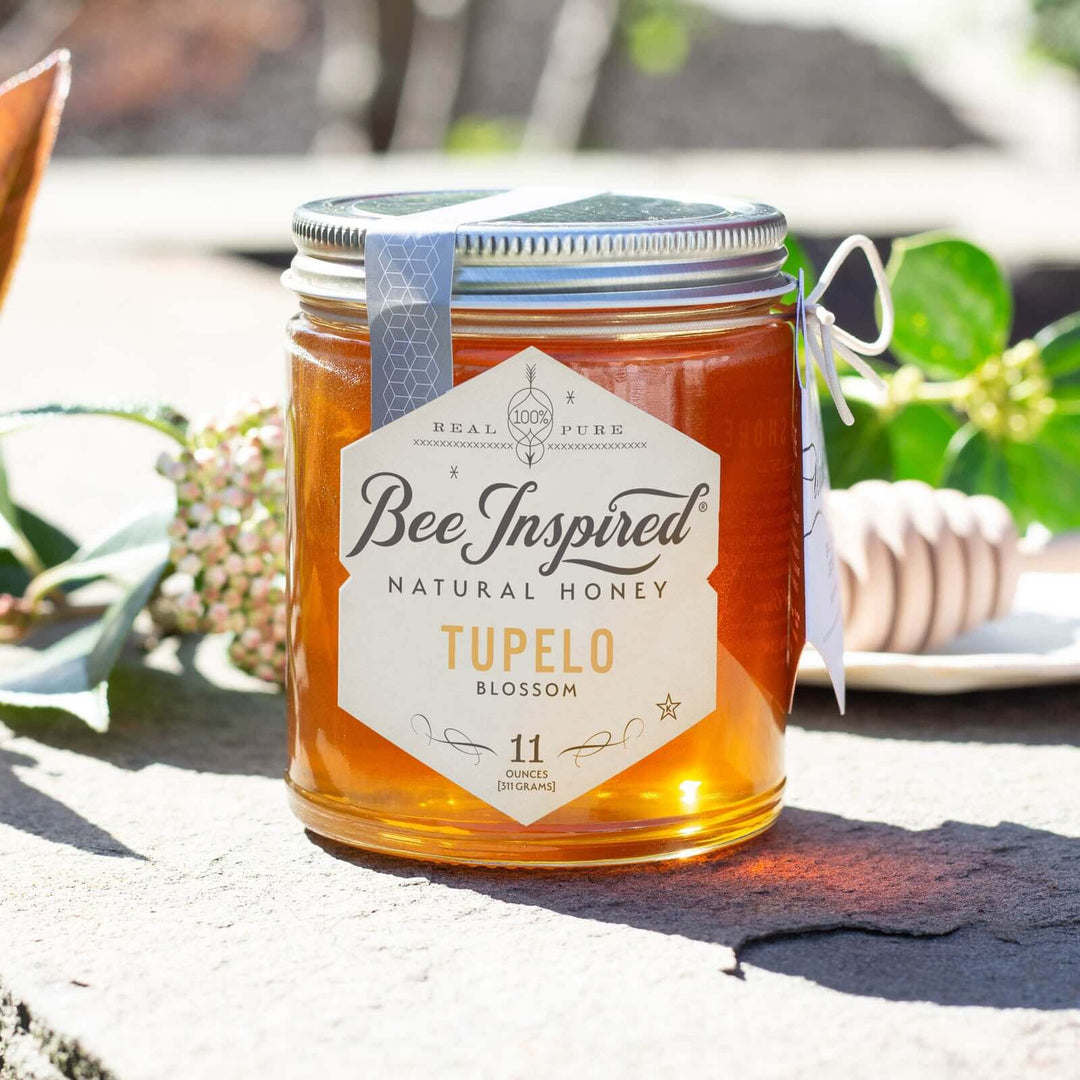Tupelo Honey - The Champagne of Honeys
Discover authentic Tupelo Honey, one of the most sought-after honey varieties in the world. This exceptional monofloral honey comes from the delicate white tupelo trees (Nyssa ogeche) that bloom for just a few weeks each spring in the swamplands and river basins of the southeastern United States.
Often called "liquid gold" or the "champagne of honeys," true Tupelo Honey delivers a taste unlike any other – buttery, smooth, with subtle floral notes and hints of cinnamon and vanilla that dance on your tongue.
Why Tupelo Honey Is So Special
The Rarest American Honey: Tupelo Honey represents one of nature's most precious treasures. The white tupelo trees bloom for only two to four weeks each year, creating an incredibly narrow window for production. This brief blooming period, combined with specific environmental requirements, makes genuine Tupelo Honey remarkably rare.
These trees grow primarily along the banks of four major rivers and wetlands: the Apalachicola, Chipola, Choctawhatchee, and Ochlocknee in the Florida panhandle and southern Georgia. The unique geography and climate of this region create the perfect conditions for white tupelo trees to thrive.
Environmental challenges facing tupelo habitats have led to declining production over the years. U.S. Geological Survey reports document significant loss of white tupelo trees since the mid-1900s, making each jar of authentic Tupelo Honey even more precious.
The Song That Made It Famous: You may recognize Tupelo Honey from Van Morrison's legendary 1971 album and title track "Tupelo Honey," recorded with producer Ted Templeman. Written in Woodstock, New York, the song immortalized this sweet treasure in music history.
Van Morrison sang about love as sweet as Tupelo Honey, and the comparison captures perfectly why this honey touches the soul. The song introduced generations of people to this Southern delicacy, inspiring them to seek out and taste the real thing.
Country music star Tim McGraw also references Tupelo Honey in his song "Southern Girl," continuing the tradition of comparing the sweetest things in life to this remarkable honey. These cultural references reflect just how deeply Tupelo Honey has influenced American culture and captured hearts across the world.
The Distinctive Taste of Tupelo Honey
Flavor Profile: The taste of Tupelo Honey sets it apart from every other honey variety. Experience a mild yet sophisticated sweetness that's less assertive than most honeys. The first notes that touch your tongue bring hints of cinnamon, followed by delicate jasmine or light citrus undertones.
As the honey spreads across your palate, buttery undertones emerge, creating a velvety, mellow sweetness. Some describe detecting subtle vanilla notes or gentle floral essences. The finish is clean and refined, without the heavy sweetness that characterizes many common honey varieties.
This unique flavor comes directly from the nectar of white tupelo tree flowers – those fragile, sunburst-shaped blossoms that appear so briefly each spring. The trees' biology creates nectar with a distinctive composition that bees transform into honey unlike anything else.
Color and Appearance: Fresh Tupelo Honey straight from the hive displays a beautiful light golden amber color with a characteristic greenish cast. This subtle green hue comes from the green pollen of tupelo trees and serves as a hallmark of authenticity.
The honey glows with clarity and brightness, reflecting its purity and minimal processing. Unlike darker honey varieties, Tupelo Honey brings a luminous quality that seems to capture sunshine itself.
Texture That Never Changes
One of Tupelo Honey's most remarkable features is its silky, flowing texture. The consistency glides smoothly, making it perfect for drizzling over foods or stirring into beverages. No thick, heavy mouthfeel – just pure liquid silk.
The Secret: Why Tupelo Honey Never Crystallizes
The Science Behind the Magic: While most honey varieties eventually crystallize and turn grainy, Tupelo Honey resists this transformation remarkably. This rare quality stems from its unique sugar composition – specifically, its high fructose-to-glucose ratio.
The fructose-to-glucose ratio in Tupelo Honey measures approximately 1.50:1, compared to the typical 1.09:1 ratio found in other honey types. This higher proportion of fructose keeps the honey in liquid form for extended periods – even years.
Here's why this matters: glucose is the sugar that crystallizes and forms solid chunks over time. Fructose, however, remains dissolved and doesn't separate from the liquid. With more fructose than glucose, Tupelo Honey stays smooth and pourable without the hassle of reheating or dealing with crystallized honey.
A Honey That Lasts: This crystallization resistance gives Tupelo Honey exceptional shelf life. Store it properly at room temperature, and it will maintain its liquid state far longer than other honey varieties. No chunky texture, no need to warm it back to liquid – just smooth, sweet perfection ready whenever you need it.
This quality makes Tupelo Honey especially convenient for everyday use. Drizzle it fresh from the jar onto breakfast foods, stir it into hot tea without waiting for crystals to dissolve, or use it in recipes where pourable honey matters.
How Tupelo Honey Is Produced
The Blooming Season: Each spring, as temperatures warm and water levels rise in the swamplands, white tupelo trees burst into bloom. The timing varies slightly year to year depending on weather conditions, but the blooming period typically occurs during April and May.
The trees produce delicate white flowers shaped like tiny sunbursts, which glisten with abundant nectar when conditions are right. These blossoms are notoriously fragile – in good years, they may bloom for several weeks, but in challenging years, the nectar flow might last only a few days.
Weather plays a crucial role in production. The trees need adequate rainfall and flooding to thrive, yet too much rain during bloom can wash away the nectar. Temperature fluctuations can shorten or delay the blooming period. These variables make Tupelo Honey production unpredictable from year to year.
The Beekeepers' Challenge: Producing pure Tupelo Honey requires extraordinary dedication and skill from beekeepers. Many truck their hives into the region to access the blooming trees. The most committed beekeepers, however, use river barges to transport their bees deep into the swamplands.
By navigating these remote waterways, beekeepers can position their hives in locations where bees feed exclusively on white tupelo blossoms. This careful placement ensures the honey captures the true essence of tupelo – any mixing with other nectar sources can diminish the distinctive flavor and characteristics.
Before releasing their bees to forage, beekeepers clean their hives completely, removing all stored honey from previous flower sources. This prevents contamination that would compromise purity. They watch the trees closely, timing the hive placement precisely to coincide with peak bloom.
During the brief season, beekeepers work around the clock. They must harvest the honey promptly as the blooming period ends, before bees begin visiting other flowers. The labor involved for both beekeepers and their bees is intense, but the result – genuine Tupelo Honey – makes the effort worthwhile.
A Shrinking Resource: The tupelo ecosystem faces ongoing environmental challenges. Dams built on the Chattahoochee and Flint Rivers, along with increased agricultural development in southwest Georgia, have reduced water flow to the Apalachicola River floodplain. White tupelo trees require periodic flooding to survive and reproduce.
The New York Times estimates that fewer than 200 beekeepers now produce commercial quantities of Tupelo Honey, as of recent years. Natural disasters like Hurricane Michael in 2018 have further impacted both trees and beehives in the region.
These factors make Tupelo Honey increasingly precious. Each jar represents not just skilled beekeeping but also the preservation of a unique natural habitat. When you purchase Tupelo Honey, you support the beekeepers and ecosystems that protect this remarkable tree species.
Culinary Uses and Serving Ideas
At the Table: Tupelo Honey shines in simple applications that showcase its delicate flavor. Drizzle it over warm biscuits or cornbread for an authentic Southern breakfast. The mild sweetness complements rather than overwhelms these traditional foods.
Try it on artisanal breads, croissants, or toast where its buttery undertones enhance the bread's natural flavors. Some customers simply enjoy a spoonful straight from the jar, savoring the pure taste without any additions.
Pairing with Cheese: The refined sweetness of Tupelo Honey makes it exceptional for cheese pairings. It complements both mild and sharp cheeses beautifully. Serve it with soft goat cheese, creamy brie, or aged cheddar for sophisticated appetizers.
Create an impressive cheese board by drizzling Tupelo Honey over your selections and adding nuts, fresh fruit, and crackers. The honey's subtle flavor profile works harmoniously with cheese without competing for attention.
In Beverages: Stir Tupelo Honey into premium teas to enhance their natural flavors without overwhelming delicate notes. Its smooth consistency dissolves easily in hot tea, creating a refined sweetness that tea enthusiasts appreciate.
Add it to coffee for a touch of natural sweetness with character. The vanilla and cinnamon hints complement coffee's roasted notes while the buttery texture creates a luxurious mouthfeel.
Baking and Cooking: Incorporate Tupelo Honey into special occasion baking for unparalleled depth. Its unique flavor brings sophistication to cakes, cookies, and pastries. The honey's moisture-retaining properties help create tender, long-lasting baked goods.
Use it in glazes for grilled peaches, roasted pears, or other fruits where its delicate sweetness won't overpower the fruit's natural taste. It caramelizes beautifully, creating glossy, flavorful coatings.
Try it in marinades or dressings where its smooth texture emulsifies easily. The subtle flavor works well in both sweet and savory applications, bringing refinement to everyday recipes.
Dessert Applications: Drizzle Tupelo Honey over vanilla ice cream, pistachio gelato, or Greek yogurt. The contrast between cold desserts and room-temperature honey creates an appealing textural experience.
Use it to sweeten fresh berries or fruit salads without masking the fruit's natural flavors. The light sweetness enhances rather than hides the fresh taste of seasonal produce.
The Cultural Legacy
Southern Gold: In the southeastern United States, Tupelo Honey holds a special place in regional food culture. It's sold in exclusive gourmet shops in New York City and major cities across America, yet many connoisseurs seek it out directly from local producers in the tupelo region.
Small family operations and mom-and-pop stores in the Florida panhandle and southern Georgia offer the freshest Tupelo Honey, often harvested just weeks before purchase. Food enthusiasts have been known to travel considerable distances specifically to buy Tupelo Honey from these local sources.
The town of Wewahitchka, Florida, hosts an annual Tupelo Honey Festival where beekeepers from the region showcase their finest products. A friendly rivalry exists between Georgia and Florida producers over which state creates the best Tupelo Honey.
A Honey for Special Moments: Tupelo Honey represents more than just a sweet treat – it embodies tradition, craftsmanship, and the unique character of a specific place. Each jar connects you to the swamplands where white tupelo trees grow, the skilled beekeepers who work tirelessly during the brief season, and generations of people who have treasured this honey.
The cultural references in music and film reflect how Tupelo Honey has captured the American imagination. When Van Morrison compared love to Tupelo Honey, he chose the perfect metaphor – something rare, sweet, and worth seeking out.
Why Our Tupelo Honey
Authentic and Pure: Our Royale Tupelo Honey comes from trusted beekeepers working in the traditional tupelo region. These dedicated professionals position their hives in prime locations along the river systems where white tupelo trees grow in abundance.
We source only genuine Tupelo Honey produced during the brief blooming season. The honey arrives raw and minimally filtered, preserving all the natural characteristics that make Tupelo Honey so special. No blending, no adulteration – just pure liquid gold from the tupelo swamps.
Limited Availability: As a seasonal delicacy produced in small batches, Tupelo Honey availability is limited. The unpredictable nature of the bloom, combined with declining tupelo tree populations, means production varies significantly from year to year.
We recommend purchasing when available, as supplies often sell out during the season. Many customers buy multiple jars when they find authentic Tupelo Honey, knowing they may not encounter it again for months.
A Collector's Item: For honey enthusiasts and culinary adventurers, genuine Tupelo Honey represents a true collector's item. Its rarity, distinctive flavor, and cultural significance make it one of the most sought-after honey varieties worldwide.
Demand for Tupelo Honey consistently outpaces supply. This imbalance reflects both the honey's exceptional quality and the limited production capacity of the tupelo region. When you secure a jar, you own something genuinely special.
The Perfect Gift: Tupelo Honey makes an impressive gift for food lovers, home cooks, or anyone who appreciates rare, artisanal products. Its reputation as the "champagne of honeys" conveys sophistication and thoughtfulness.
The honey's cultural connections make it meaningful for music fans, particularly those who love Van Morrison's work. Share a jar with friends or family members who appreciate unique regional foods and the stories behind them.
Package it with Southern-style foods like specialty biscuit mixes or artisanal cornmeal for a complete regional gift basket. Include information about the white tupelo trees and the challenging process of harvesting this honey to enhance appreciation for its rarity.
Understanding Value and Quality
The Gold Standard: Tupelo Honey serves as the gold standard by which other honeys are measured. Its superior taste, unique crystallization resistance, and limited availability place it at the pinnacle of honey varieties.
The price of genuine Tupelo Honey reflects its rarity and the extraordinary effort required to produce it. Unlike widely available honey varieties, Tupelo Honey comes exclusively from a small geographic region during a brief seasonal window. The labor-intensive harvest process and environmental challenges facing tupelo habitats contribute to its value.
Recognizing Authenticity: Authentic Tupelo Honey displays several distinctive characteristics. Look for that characteristic greenish cast when the honey is fresh from the hive. The flavor should be mild and buttery with subtle floral notes – never aggressively sweet or strongly flavored.
True Tupelo Honey remains liquid for extended periods without crystallizing. If honey labeled as "Tupelo" crystallizes quickly, it likely contains significant amounts of other nectar sources. The smooth, flowing texture should persist year after year when stored properly.
Supporting Traditional Beekeeping: When you purchase authentic Tupelo Honey, you support traditional beekeeping practices and help protect the unique tupelo ecosystem. The fewer than 200 commercial Tupelo Honey producers work to maintain this heritage and preserve white tupelo habitats for future generations.
Your purchase demonstrates that consumers value rare, authentic products produced sustainably and with care. This support encourages beekeepers to continue their challenging work despite environmental pressures and market uncertainties.
Storage and Handling: Store your Tupelo Honey at room temperature in a cool, dry location away from direct sunlight. Keep the lid tightly sealed to prevent moisture absorption. Unlike other honeys, you won't need to worry about crystallization – Tupelo Honey's unique composition keeps it liquid naturally.
Avoid refrigeration, which can affect texture even in crystallization-resistant honey. A pantry or cupboard provides the ideal storage environment. Properly stored, Tupelo Honey maintains its quality for years, though its exceptional taste may inspire you to finish it much sooner!
Order Your Tupelo Honey Today
Experience the honey that inspired songs, captured hearts, and earned its title as the "champagne of honeys." Each 11 oz jar contains liquid gold from the swamplands of the American South – rare, refined, and remarkably delicious.
From your morning biscuits to elegant cheese boards, from special occasion baking to simple spoonfuls of pure pleasure, Tupelo Honey brings sophistication and sweet memories to every use. Its buttery smoothness, subtle flavors, and crystallization resistance make it a joy to keep in your home.
This is honey for life's special moments and everyday indulgences alike. Add it to your cart now while supplies last. Discover why generations of food lovers, from Southern grandmothers to big-city gourmets, consider Tupelo Honey one of nature's most perfect creations.
Whether you're a longtime fan who knows exactly what makes Tupelo Honey special, or a curious newcomer ready to understand what Van Morrison was singing about, your journey with this exceptional honey begins here. Don't miss your chance to taste the champagne of honeys – genuine Tupelo Honey from the white tupelo trees of the American South.

























